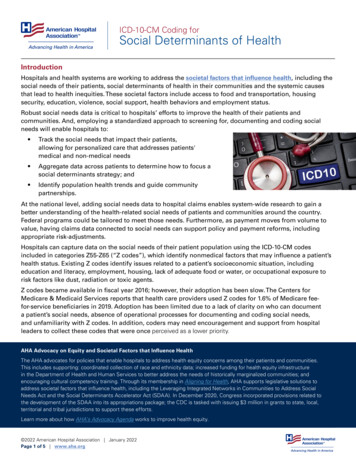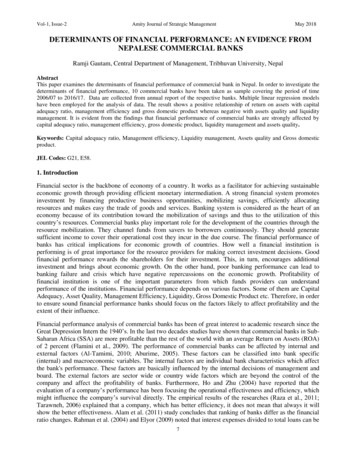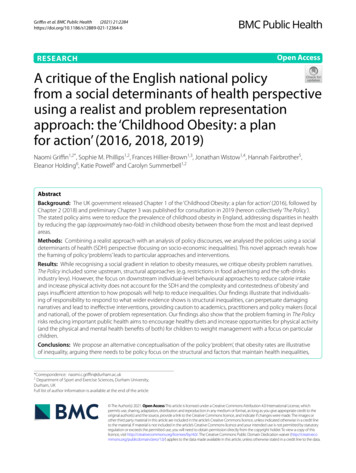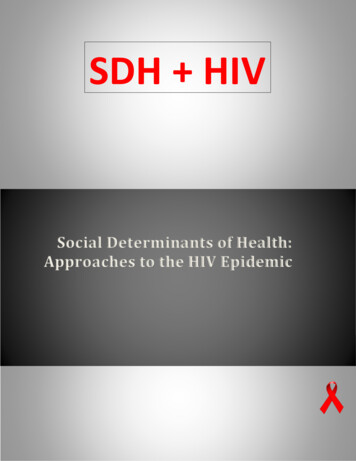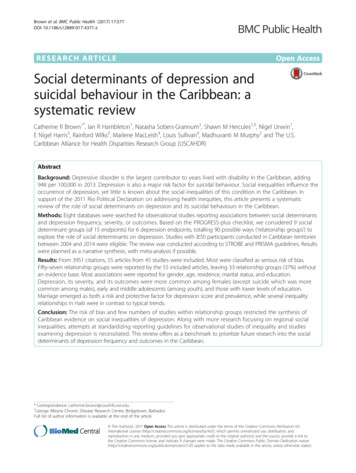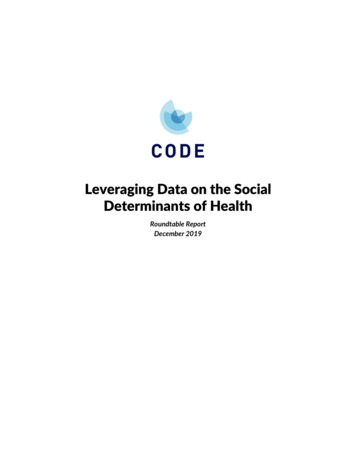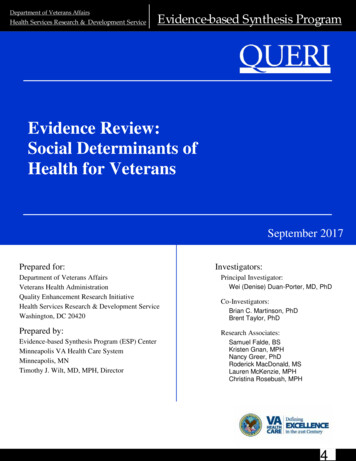
Transcription
4Department of Veterans AffairsHealth Services Research & Development ServiceEvidence-based Synthesis ProgramEvidence Review:Social Determinants ofHealth for VeteransSeptember 2017Prepared for:Investigators:Department of Veterans AffairsVeterans Health AdministrationQuality Enhancement Research InitiativeHealth Services Research & Development ServiceWashington, DC 20420Principal Investigator:Prepared by:Research Associates:Evidence-based Synthesis Program (ESP) CenterMinneapolis VA Health Care SystemMinneapolis, MNTimothy J. Wilt, MD, MPH, DirectorWei (Denise) Duan-Porter, MD, PhDCo-Investigators:Brian C. Martinson, PhDBrent Taylor, PhDSamuel Falde, BSKristen Gnan, MPHNancy Greer, PhDRoderick MacDonald, MSLauren McKenzie, MPHChristina Rosebush, MPH4
Social Determinants of Health for VeteransEvidence-based Synthesis ProgramPREFACEThe VA Evidence-based Synthesis Program (ESP) was established in 2007 to provide timely andaccurate syntheses of targeted healthcare topics of particular importance to clinicians, managers, andpolicymakers as they work to improve the health and healthcare of Veterans. QUERI provides fundingfor four ESP Centers, and each Center has an active University affiliation. Center Directors arerecognized leaders in the field of evidence synthesis with close ties to the AHRQ Evidence-basedPractice Centers. The ESP is governed by a Steering Committee comprised of participants from VHAPolicy, Program, and Operations Offices, VISN leadership, field-based investigators, and others asdesignated appropriate by QUERI/HSR&D.The ESP Centers generate evidence syntheses on important clinical practice topics. These reports help: Develop clinical policies informed by evidence; Implement effective services to improve patient outcomes and to support VA clinical practiceguidelines and performance measures; and Set the direction for future research to address gaps in clinical knowledge.The ESP disseminates these reports throughout VA and in the published literature; some evidencesyntheses have informed the clinical guidelines of large professional organizations.The ESP Coordinating Center (ESP CC), located in Portland, Oregon, was created in 2009 to expand thecapacity of QUERI/HSR&D and is charged with oversight of national ESP program operations, programdevelopment and evaluation, and dissemination efforts. The ESP CC establishes standard operatingprocedures for the production of evidence synthesis reports; facilitates a national topic nomination,prioritization, and selection process; manages the research portfolio of each Center; facilitates editorialreview processes; ensures methodological consistency and quality of products; produces “rapid responseevidence briefs” at the request of VHA senior leadership; collaborates with HSR&D Center forInformation Dissemination and Education Resources (CIDER) to develop a national disseminationstrategy for all ESP products; and interfaces with stakeholders to effectively engage the program.Comments on this evidence report are welcome and can be sent to Nicole Floyd, ESP CC ProgramManager, at Nicole.Floyd@va.gov.Recommended citation: Duan-Porter W, Martinson BC, Taylor B, Falde S, Gnan K, Greer N,MacDonald R, McKenzie L, Rosebush C, Wilt TJ. Evidence Review: Social Determinants of Health forVeterans. VA ESP Project #09-009; 2017.This report is based on research conducted by the Evidence-based Synthesis Program (ESP) Center located at theMinneapolis VA Health Care System, Minneapolis, MN, funded by the Department of Veterans Affairs, VeteransHealth Administration, Office of Research and Development, Quality Enhancement Research Initiative. The findingsand conclusions in this document are those of the author(s) who are responsible for its contents; the findings andconclusions do not necessarily represent the views of the Department of Veterans Affairs or the United Statesgovernment. Therefore, no statement in this article should be construed as an official position of the Department ofVeterans Affairs. No investigators have any affiliations or financial involvement (eg, employment, consultancies,honoraria, stock ownership or options, expert testimony, grants or patents received or pending, or royalties) thatconflict with material presented in the report.i
Social Determinants of Health for VeteransEvidence-based Synthesis ProgramTABLE OF CONTENTSExecutive Summary . 1Introduction . 1Methods. 2Development of Conceptual and Analytic Frameworks . 2Data Sources and Searches . 2Study Selection . 2Data Abstraction and Quality Assessment . 3Data Synthesis and Analysis . 3Results . 4Results of Literature Search . 4Summary of Results for Key Questions. 4Discussion . 6Key Findings . 6Applicability and Implications for Policy and Practice . 6Research Gaps/Future Research . 7Conclusions . 8Abbreviations Table . 8Evidence Report . 9Introduction . 9Methods. 10Development of Conceptual and Analytic Frameworks . 10Key Questions . 13PICO . 13Search Strategy . 16Study Selection . 16Inclusion Criteria . 16Exclusion Criteria . 17Data Abstraction . 17Quality Assessment . 18Data Synthesis . 18Rating the Body of Evidence . 18Peer Review . 18Results . 19ii
Social Determinants of Health for VeteransEvidence-based Synthesis ProgramKey Question 1: How do Veterans compare to non-Veterans in prevalenceand characteristics of social determinants of health? . 20Key Question 2: Does variation in social determinants of health account fordifferences in health services access, health behaviors, and health outcomesbetween Veterans and non-Veterans? . 20Key Messages . 20Evidence Map . 20Qualitative Synthesis of Results for Rurality, Trauma, and Sexual Orientationand Gender Identity for Veterans and Non-Veterans . 21Key Question 3: How do engaged (ie, enrolled in or utilizing categories ofVHA services or benefits) Veterans compare to non-engaged (ie, not enrolledin or utilizing VHA services or benefits) Veterans in prevalence and characteristicsof social determinants of health? . 25Key Question 4: Does variation in social determinants of health account fordifferences in health services access, health-related behaviors, and health outcomesbetween engaged Veterans and non-engaged Veterans? . 25Key Messages: . 25Evidence Map . 25Qualitative Synthesis of Results for Rurality, Trauma, Sexual Orientation andGender Identity for Veterans Engaged and Not Engaged in VHA Care . 26Summary and Discussion . 29Summary of Evidence for Key Questions 1 and 2 . 29Summary of Evidence for Key Questions 3 and 4 . 29Limitations . 30Applicability and Implications for Policy and Practice . 31Research Gaps/Future Research . 31Conclusions . 33References . 35Appendix A. Search Strategies . 46Appendix B. Peer Review Comments/Author Responses . 49Appendix C. Evidence Tables . 61TABLESTable 1. Social Determinants of Health . 10Table 2. Characteristics of Included Articles for Rurality, Trauma, and Sexual Orientation—Veterans and Non-Veterans . 22iii
Social Determinants of Health for VeteransEvidence-based Synthesis ProgramTable 3. Characteristics of Included Articles for Rurality and Trauma—Veterans Engaged andNot Engaged in VHA Services or Benefits. 27FIGURESFigure 1. Conceptual Framework for Social Determinants of Veterans’ Health . 12Figure 2. Analytic Framework for Key Questions 1 and 2 . 14Figure 3. Analytic Framework for Key Questions 3 and 4 . 15Figure 4. Citation Screening and Selection of Included Articles. 19Figure 5. Summary of Included Articles Addressing Social Determinants and VariousOutcomes for Veterans and non-Veteransa . 21Figure 6. Summary of Included Articles Addressing Social Determinants and VariousOutcomes for Veterans Engaged and Not Engaged in VHA Carea . 26iv
Social Determinants of Health for VeteransEvidence-based Synthesis ProgramEVIDENCE REPORTINTRODUCTIONSocial determinants of health are broad and often defined in the context of other factors that alsoimpact health. For example, the Institute of Medicine’s (IOM) report, Capturing Social andBehavioral Domains and Measures in Electronic Health Records, defined social determinants as“sociocultural, socio-economic, and socio-demographic status; biosocial interactions; and thevarious levels of social context ”1 This IOM report differentiated social from behavioralfactors in that the latter indicate observable actions, underlying cognitions, and/or other relatedpsychological constructs. Similarly, Tarlov’s framework posited “social and societalcharacteristics” as one of 5 major categories of determinants of population health, with the othersbeing genes and biology, health behaviors, medical care, and the “ecology of all living things.”2Although exact definitions vary somewhat, there is consensus that social determinants includemany distinct concepts, and taken as a whole, they substantially influence health outcomes andcontribute to health disparities.2,3,4-6The VHA Office of Patient Care Services—Population Health Services and Office of RuralHealth (hereafter, VHA partners) requested an evidence review to examine social determinantsof Veterans’ health, particularly as to those social determinants which may be more important forVeterans’ health outcomes (or for certain Veteran groups), as compared with non-Veterans. Thegoal for this evidence review was to guide VHA planning for health care services that may beinfluenced by, or should be targeted to social determinants contributing to poorer health andgreater care needs among Veterans. In collaboration with our VHA partners, we developed thescope and conceptual framework for an evidence map, with the focus being social determinantsthat may be differentially important for Veterans compared with non-Veterans, or betweenVeterans enrolled in or utilizing certain VHA services, compared with those Veterans who didnot. An evidence map is a scoping review that describes key characteristics of existing, publishedevidence for a broad area of medicine and health.7,8 Given our goals focused on Veterans, ourevidence map did not seek to identify and review the evidence for all social determinants ofhealth, irrespective of populations. Furthermore, in trying to balance the extensive scope of ourreview with the goal of providing results that have clear implications for VHA policy and futureresearch, we engaged our VHA partners in a prioritization process after the initial evidence map,and selected those social determinants which would undergo more detailed review and reportingof published results (ie, rurality, trauma history, sexual orientation and gender identity).9
Social Determinants of Health for VeteransEvidence-based Synthesis ProgramMETHODSDEVELOPMENT OF CONCEPTUAL AND ANALYTIC FRAMEWORKSIn developing our approach for systematically identifying, describing, and interpreting theevidence base for social determinants of Veterans’ health, we worked with our VHA partners tofirst establish a conceptual framework that depicts the complex relationships between socialdeterminants of health, Veteran status or experiences, and health outcomes (Figure 1). Thisframework draws upon work from the MacArthur Research Network on Socioeconomic Statusand Health9 and the IOM report on prioritization of social determinants for capture by healthrecords.1 We sought to be inclusive and broad in conceptualizing relevant social determinants,but also considered whether particular social determinants have available measures, and whetherthey are considered as high priority by national groups and our VHA partners (Table 1). We notethat while certain social determinants are consistently named but variably defined or measured(eg, income), other social determinants are both inconsistently described and measured (eg,exposures to trauma and adversity), thus limiting our ability to compare across past reports andexisting frameworks. Nevertheless, development of this conceptual framework with our VHApartners and identification of a starting set of social determinants were critical for clarifying theobjectives of our partners and informing our search strategies.Table 1. Social Determinants of HealthStandardized MeasureAvailableHigh Prioritya forCapture by Health RecordsIndividual ual OrientationGender IdentityNRSocial Relationships and Living Conditions:üMarital StatusNRüüSocial SupportüFamily SESüüTrauma HistoryJustice InvolvedNRHousing StatusNRüRuralityNRaResults adapted from report by Institute of Medicine (2014) Capturing social and behavioral domains andmeasures in electronic health records: Phase 2; NR not rated in reportOur conceptual framework highlights some of the complexities arising in the study of socialdeterminants. First, we separated age, race/ethnicity, and sex into their own category, as keydemographic characteristics that are distinct from social determinants of health. We acknowledgethat these factors have social components (eg, definitions of race and ethnicity) and likelyinteract with social determinants, but they also may be associated with biologic/physiologicvariation that impacts health through non-social pathways. The different pathways by which age,10
Social Determinants of Health for VeteransEvidence-based Synthesis Programrace, and sex impact health are often not distinguished in studies examining outcomes, andattempting to understand the “social” components is beyond the scope of this evidence review.Furthermore, a recent VHA ESP report has focused on health disparities among Veterans, andthus, evaluated the current evidence base for health outcomes associated with these keydemographic factors.10 Thus, our expectation is that robust analyses of impact of socialdeterminants should account for age, race, and sex, in alignment with our main goal ofexamining the evidence base for social determinants against the backdrop of known impacts ofthese factors.Other important considerations include the potential for differential selection of individuals intomilitary service along one or more dimensions of social determinant, nonlinearity inrelationships between factors, feedback loops within the complex system of relationships, andinteractive dynamic effects due to bidirectionality. Over the life course, pathways are also likelyto vary in their influence on health outcomes (eg, adversity in childhood vs adulthood). Ourmodel also depicts how social determinants may influence Veteran experiences and engagementwith VHA resources, with Veteran status being a mediator of social determinants on healthoutcomes. For example, a study examining the role of social determinants in health of Veteranscompared with non-Veterans addressed the need to distinguish between potential impact ofsocial determinants on differential selection into military service and the other pathways bywhich social determinants may impact health for Veterans.11 Alternatively, Veteran status orexperience may impact social determinants (eg, effect on educational attainment or access toaffordable housing), in which case social determinants are mediating the health effects ofVeteran status. Additionally, social determinants could moderate the relationship betweenVeteran experiences and health (ie, differentially modulating the strength or direction of suchassociations). Importantly, these distinct roles of social determinants would be examined usingdifferent analytic techniques (eg, tests for mediation vs examining interaction effects). Forexample, if trauma exposures have moderating effects, we might observe that the associationbetween Veteran status and health outcome is stronger or weaker among Veterans who haveexperienced trauma, compared with non-Veterans who have similar exposures. In contrast, iftrauma mediates the impact of Veteran status on health, we would find that accounting fortrauma exposure would decrease or change the associations between Veteran experiences andhealth outcomes.11
Social Determinants of Health for VeteransEvidence-based Synthesis ProgramFigure 1. Conceptual Framework for Social Determinants of Veterans’ HealthAccess to BasicNeeds (eg, healthcare, housing, tion-Income-Employment-Marital status-Social support-Trauma history-Rurality-Sexual orientation& gender identityVeteranStatus/ExperienceaHealth Outcomes:-Medical conditions-Mental healthconditions-Disability-Quality of life-MortalityHealth Behaviors:-Substance use-Risk-takingVeteran Status/Experience refers to whether one is a Veteran, including deployed and non-deployed, and various eras of service12
Social Determinants of Health for VeteransEvidence-based Synthesis ProgramIn accordance with our conceptual framework, we developed 2 analytic frameworks (Figures 2and 3) to further clarify our key questions and inform our search strategies. The analyticframeworks helped to identify the populations of interest, highlight social determinants that arelikely relevant, define outcomes of interest, and determine the inclusion/exclusion criteria for theevidence review. In comparing our analytic frameworks with the more complex conceptualframework described above, we note 2 key simplifications. First, we are primarily concernedwith social determinants as mediators of the effects of Veteran status, or engagement in VHAservices or benefits. Thus, in the analytic frameworks, we have not included the potential impactof social determinants on Veteran status (Figure 2) or engagement with the VHA amongVeterans (Figure 3). Second, we have indicated unidirectional relationships throughout (eg,social determinants affecting health directly, or affecting health services access which in turnaffects health) because these are the associations most likely to be examined by publishedstudies, and they are most relevant to addressing the policy concerns of our VHA partners.Evaluating bidirectional relationships between social determinants and health would requirerobust longitudinal data and more complex analytic techniques. Although such studies would behighly desirable, we did not expect most of the evidence base to fall into this category.Below, we provide our 4 key questions, and a summary of these questions in PICO format. InKey Questions 3 and 4, we use the terms “engaged” and “non-engaged” to describe groups ofVeterans who differ according to enrollment in VHA or other VA benefits and services, orutilization of categories of VHA services (eg, mental health or other specialty care).Key QuestionsKey Question 1: How do Veterans compare to non-Veterans in prevalence and characteristics ofsocial determinants of health?Key Question 2: Does variation in social determinants of health account for differences in healthservices access, health-related behaviors, and health outcomes between Veterans and nonVeterans?Key Question 3: How do engaged (ie, enrolled in or utilizing categories of VHA services orbenefits) Veterans compare to non-engaged (ie, not enrolled in or utilizing VHA services orbenefits) Veterans in prevalence and characteristics of social determinants of health?Key Question 4: Does variation in social determinants of health account for differences in healthservices access, health-related behaviors, and health outcomes between engaged Veterans andnon-engaged Veterans?PICOPopulation: Adult Veterans and non-VeteransIntervention, Comparator: Not applicablePrimary Outcome: Prevalence and differences in social determinants of healthSecondary Outcomes: Differences in health services access, health-related behaviors, and healthoutcomes, as related to differences in social determinants of health13
Social Determinants of Health for VeteransEvidence-based Synthesis ProgramFigure 2. Analytic Framework for Key Questions 1 and 2Access to services and benefits(eg, health care, housing)VeteransaUS AdultsNonVeteransSocial Determinants:-Education-Income-Employment-Marital status-Social support-Trauma history-Rurality-Sexual orientation &gender identityHealth Outcomes:-Medical conditions-Mental health conditions-Disability-Quality of life-MortalityHealth Behaviors:-Substance use-Risk-takingaIncludes deployed and non-deployed, and various eras of service14
Social Determinants of Health for VeteransEvidence-based Synthesis ProgramFigure 3. Analytic Framework for Key Questions 3 and 4Access to services and benefits(eg, health care, housing)VeteransEngagedin VHAServicesaUS AdultsVeteransNotEngagedin VHAServicesaSocial Determinants:-Education-Income-Employment-Marital status-Social support-Trauma history-Rurality-Sexual orientation &gender identityHealth Outcomes:-Medical conditions-Mental health conditions-Disability-Quality of life-MortalityHealth Behaviors:-Substance use-Risk-takingaEngagement in VHA services included use of any VHA benefits or specific categories of services (eg, mental health care), as defined by authors of articles.15
Social Determinants of Health for VeteransEvidence-based Synthesis ProgramSEARCH STRATEGYWe undertook a multi-faceted approach to identifying published articles that may be relevant toour key questions. First, we searched MEDLINE (OVID), the Cumulative Index to Nursing andAllied Health Literature (CINAHL), PsycINFO, and Sociological Abstracts, from the date ofinception for each database to January 2017, for English language publications. Full databasesearch strategies are presented in Appendix A. To these search results, we added referencessuggested by experts and peer reviewers. To assess our search results, and also to explore greyliterature sources (eg, white papers) that may contribute to the evidence base, we undertook anevaluation of publications associated with multiple large national cohorts (eg, AmericanCommunity Survey, Behavioral Risk Factor Surveillance System), and some VA researchprograms. We first reviewed whether our database search results included articles that used datafrom these cohorts. Then, we screened citations/abstracts and reports that were associated withthese cohorts, as indicated by publication lists, bibliographies, or other available information. Weapplied this same process to articles and other publications associated with the VA EpidemiologyProgram and the National Center for Veterans Analysis and Statistics. In general, we did notidentify robust sources of evidence in the grey literature that substantially added to our originalsearch focused on peer-reviewed journal articles. Finally, in addition to the database searchesand evaluation of publications associated with large national cohorts, we also completed anexpedited review of citations found through a MEDLINE search with the terms as noted above(Appendix A), except using “trials” instead of selecting for other study designs. We thought itunlikely that randomized controlled trials or controlled clinical trials would address our keyquestions regarding the social determinants of health, but for completeness, we carried out thisadditional search.STUDY SELECTIONCitations/abstracts identified as potentially eligible by at least one reviewer underwent dualreview of the full texts. At the full-text review stage, 2 reviewers needed to agree on eligibility.Discrepancies were resolved by discussion or a third reviewer. Citation/abstract screening, fulltext review, and data abstraction were performed in DistillerSR, (Evidence /distillersr-systematic-review-software/; accessed 5July 2017).We applied the following inclusion and exclusion criteria:Inclusion Criteria1. Includes data on:a. US Veterans and non-Veteransand/orb. US Veterans engaged and not engaged in VHA services (NOTE: we use engaged and notengaged for comparisons of groups of Veterans based on enrollment in VHA or other VAbenefits and services, or utilization of categories of services [eg, mental health or otherspecialty care])16
Social Determinants of Healt
Social Determinants of Health for Veterans Evidence-based Synthesis Program. 10. METHODS . DEVELOPMENT OF CONCEPTUAL AND ANALYTIC FRAMEWORKS . In developing our approach for systematically identifying, describing, and interpreting the evidence base for social determinants of Veterans' health, we worked with our VHA partners to
